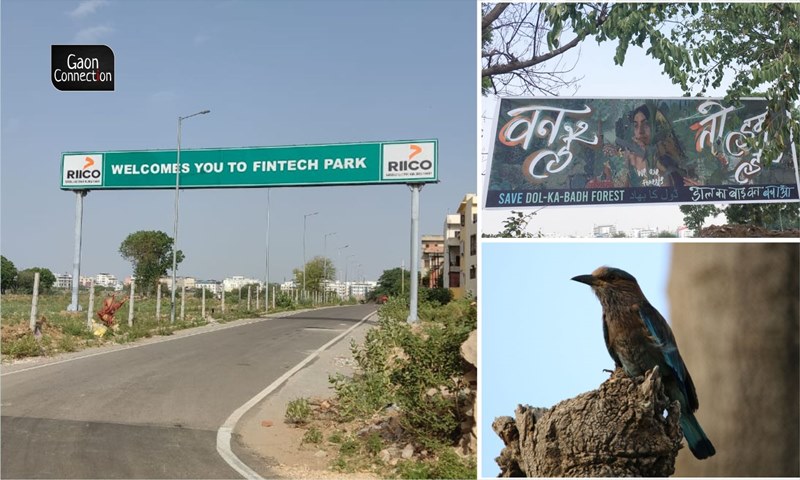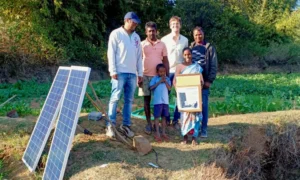Jaipur, Rajasthan
Very soon, in the 40 hectares of land, where birds, bees and vegetation flourish, there will be bulldozers, cement, gravel and sand. A large sprawl of green ‘forest land’ in Jaipur, Rajasthan is to be transformed into a glass and concrete jungle to house a Financial Technology (Fintech) Park to accommodate IT professionals and chartered accountants. The Rajasthan State Industrial Development and Investment Corporation (RIICO) will undertake the venture.
On February 24, earlier this year, the Congress party’s Ashok Gehlot-led state government declared its intent to construct the Fintech Park in its 2021-22 budget announcement, sending a chill down many spines.
The chief minister also said that it was his intention to make Jaipur a fintech city. He wanted to create a space for all the chartered accountants and IT professionals of the state who had moved away to other hubs such as NOIDA, Mumbai, Hyderabad, Bengaluru, etc.
Also Read: The desert coolers of Rajasthan
At stake is Dol ka Badh, an urban forest in the heart of Jaipur, where, it is estimated, that 1,000 trees will be felled for the fintech project and more than 100 species of birds will lose their homes in the Dol Ka Badh forest. The ‘forest land’ falls near the Dravyavati river and the Sanganer airport in Jaipur.
What’s the Fintech Park project?
On the same day the CM announced the project, giving details about the fintech park, Ashutosh Pednekar, Industries Secretary and managing director of RIICO, said that it would cover over 480,000 square meters. Of it, 55 per cent would be the built-up area.
The fintech park is to come up on Jaipur-Tonk road, near Chaya Nagar, a few kilometres away from the airport. North of this area are several residential colonies and to the south of it is the huge residential area of Sanganer.
The state government project, intended to attract IT companies to invest there, will cost Rs 1,060 million. It hopes to bring in at least Rs 30,000 million to the state as an investment.
The plan has been met with outrage from environmentalists, ecologists, social activists and local citizens.
Letters of appeal
Dol Ka Badh Bachao (Save Dol Ka Badh Forest) is the slogan for the protest. On June 23, more than 300 people from various walks of life wrote to Kuldeep Ranka, the chairperson of RIICO. On July 4, about 29 celebrities from their respective fields across the country also registered their protest with Chief Minister Ashok Gehlot and Kuldeep Ranka, voicing their dismay at the proposed project.
Environmental activist Medha Patkar, social activist and writer Aruna Roy, historian Ramachandra Guha, environmental activist and water expert Himanshu Thakkar, Gandhian and Magsaysay awardee Sandeep Pandey and poet Javed Akhtar, were some of those who wrote the letters.
The diversity that Dol Ka Badh brings to the area with its many birds will be wiped out if the fintech park comes up, said many local citizens who are also protesting the construction. They appealed to the authorities to move the construction of the fintech park elsewhere.
Voices of anguish
“In a few days thousands of trees and millions of creatures will be sacrificed at the altar of ‘human development’,” Bhanwar Meghwanshi, social activist and environmentalist from Jaipur, told Gaon Connection.
The forest that is a lung space in Jaipur has been providing clean, oxygen-rich air, free of cost, during the pandemic when people were running from pillar to post trying to buy oxygen, Meghwanshi said. Dol Ka Badh will soon meet its end for the sake of industrial development, she lamented.
Also Read: Human-wildlife conflict related killing single biggest threat to wildlife: Report
In October 2018, Vasundhara Raje who was the chief minister then, had inaugurated a beautification project on a 16-km stretch on the Dravyavati river banks. This led to woodlands coming up around the area. In three years, the forest cover in this area grew and a natural eco-system was created that became home to several rare species of birds and other creatures.
Whose land is it anyway?
According to the Land Acquisition Act of 1953, the Dol Ka Badh area was earmarked for industrial development in 1979. The land was measured and recorded as being 591 bighas and 17 biswa in area. The government took over the land, and in 1982, handed it over to RIICO.
Six years later, in 1988, the land was allotted to the Diamond and Gem Development Corporation Ltd. to set up a gem industry. But, in 1996, the lease was cancelled when the project did not take off. The company filed a case with the Rajasthan High Court against the cancelled lease, and its lease was restored.
However, RIICO appealed to the Supreme Court against the High Court order. In 2013, the land once again came into the possession of RIICO. It is now to be developed as a Fintech Park.
A RIICO official was quoted in a media report as saying that the land in question was private land that was bought by RIICO for industrial development. He also pointed out that the land did not fall under the forest department. The Supreme Court had also directed that the land was to be used for industrial use, the RIICO official added.
“The deep concern for Dol ka Badh is because this forest has come up on its own,” Sunni Sebastian, environmental activist and writer, told Gaon Connection. Even if after cutting down these trees, others are planted elsewhere, it is not the same as Nature’s way, he added. “Destroying this natural woodland will mean destroying an entire ecosystem of the area,” he added.
Demands to relocate the fintech park
Mitali Desai, a concerned citizen of Jaipur, likens the “Save Dol Ka Badh Forest” movement to the historic Chipko movement. “We will not allow this forest land to be destroyed, and we will have regular dialogues with the government and have the fintech park relocated,” she said.
Also Read: Uttarakhand villagers launch another Chipko Andolan to protect their sacred grove
On a sombre note, social worker from Jaipur, Kavita Srivastava said on July 3, a few JCBs were seen in the area of the forest, levelling the surrounding land. “It looks like the government is going forward with the idea of implementing the project,” she observed.
“We have presented our demands to the government and we are meeting the MD of RIICO soon. It remains to be seen what happens after we speak to them,” Srivastav added.
Also Read: Treeman: Bhaiyaram Yadav of Chitrakoot has created a forest with more than 40,000 trees
Supporters of the Save Dol Ka Badh Forest initiative many of whom are social workers, educationists, environmentalists, artists, poets and writers, pointed out to the chief minister that on one hand Jaipur Development Authority was making plans to plant trees and on the other RIICO was planning to uproot trees in an already existing forest. They asked why the fintech park could not be created elsewhere.
Meanwhile, as the voices of protest get louder, it remains to be seen if Dol Ka Badh will be allowed to live, or will it meet its end for the cause of ‘development’, and the birds will have to take their business elsewhere.
Read the story in Hindi.



















